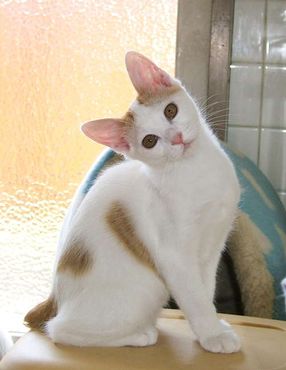Other than the Japanese Bobtail's impressive and interesting appearance, the overriding topic of interest in relation to this cat is the history of the breed and the myths and stories surrounding it as they are rooted in the history of the country.
Sculptures and illustrations made centuries ago apparently depict the Japanese Bobtail. A current, extremely common and commercialized depiction of this cat can be seen in the good luck charm, the Welcoming Cat. This is the Maneki Neko ("Beckoning Cat") figurine. The figurine is a very stylized and kitsch representation of the Japanese Bobtail, beckoning a customer in.
The Japanese way to beckon is with the palm outwards and the fingers waving in. The Western way is the back of the hand outwards. The figurine is doing it the Eastern Way and Ninja, above, the Western way.
The history behind the Beckoning Cat is worth telling briefly. There are many stories. One concerns a 17th century cat called Tama who lived with a priest. The priest wanted the cat to contribute to temple life. A dignitary was visiting the temple during a rainstorm and sheltered under a tree. Tama welcomed him in. Shortly afterwards, lightening hit the tree. As a reward the dignitary helped the temple. The legend was born.
In another story from the same period a cat's head (yes, just the head) saved the life of a geisha called Usugumo by biting the head of a snake nearby. Moments before being beheaded the cat had pulled at the hem of the geisha's robe to alert her to the snake but an admirer thought the cat a "goblin cat" and beheaded her. The raised left arm of the figurine/statue symbolizes the arm of the cat pulling at the robe.
There are apparently many other stories. The favorite colors of the Maneki Neko are the same as the cat
Sculptures and illustrations made centuries ago apparently depict the Japanese Bobtail. A current, extremely common and commercialized depiction of this cat can be seen in the good luck charm, the Welcoming Cat. This is the Maneki Neko ("Beckoning Cat") figurine. The figurine is a very stylized and kitsch representation of the Japanese Bobtail, beckoning a customer in.
The Japanese way to beckon is with the palm outwards and the fingers waving in. The Western way is the back of the hand outwards. The figurine is doing it the Eastern Way and Ninja, above, the Western way.
The history behind the Beckoning Cat is worth telling briefly. There are many stories. One concerns a 17th century cat called Tama who lived with a priest. The priest wanted the cat to contribute to temple life. A dignitary was visiting the temple during a rainstorm and sheltered under a tree. Tama welcomed him in. Shortly afterwards, lightening hit the tree. As a reward the dignitary helped the temple. The legend was born.
In another story from the same period a cat's head (yes, just the head) saved the life of a geisha called Usugumo by biting the head of a snake nearby. Moments before being beheaded the cat had pulled at the hem of the geisha's robe to alert her to the snake but an admirer thought the cat a "goblin cat" and beheaded her. The raised left arm of the figurine/statue symbolizes the arm of the cat pulling at the robe.
There are apparently many other stories. The favorite colors of the Maneki Neko are the same as the cat

0 comments:
Post a Comment